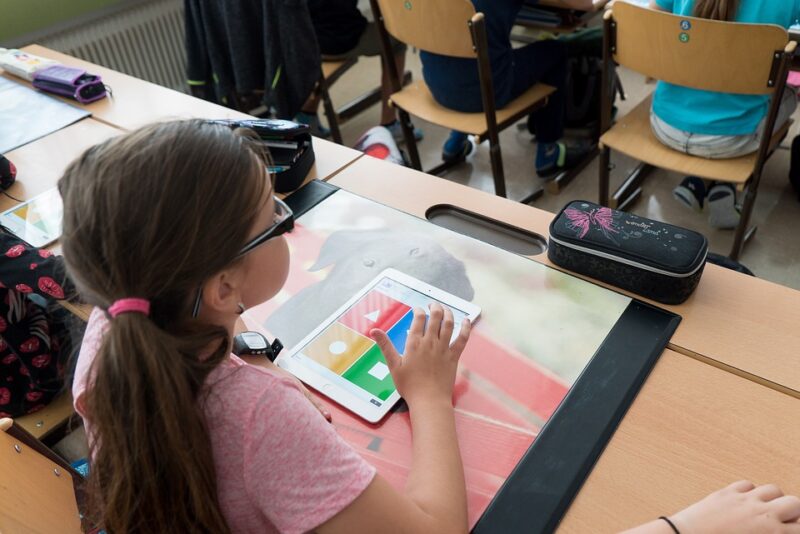Assignment 4: Technology Integration Activity
The goal of this assignment, now that I have identified an instructional problem that I want to overcome, potential educational technology tools that I can use, and key adoption and integration issues, will be to start plan an instructional activity utilizing this technology. This is my multi-day lesson plan for a component of my novel study literature circle unit that will incorporate the use of Google Classroom and FlipGrid as two supportive technologies in learning.
Blueprint Lesson Plan for Chapter 6-9 Literature Circle for To Kill a Mockingbird
Activity Description
As identified in Assignment 2 and 3, this activity will be a sample lesson featured from a multi-week literature circle unit covering Harper Lee’s To Kill a Mockingbird. Students will be reading chapters 4 – 6 and sharing their thoughts using applied reading strategies from Kyla Hadden and Adrienne Gear’s (2016) Powerful Readers: Thinking Strategies to Guide Literacy Instruction in Secondary Classrooms. Students will demonstrate these reading strategies orally through Think Alouds (Wilhelm, 2001) which will be recorded in short video segments on FlipGrid.
Scope
This lesson falls in the second major unit of a semestered English 10 course. Prior to this literature circle unit, students explored “Why Do We Tell Stories?” through a collection of short stories, which provided a foundation of knowledge for analysis in this unit. Using To Kill a Mockingbird, students explore our theme “Power, Prejudice, and Privilege” for 8 weeks through collaborative reflective online journaling, small group literature circle discussions, and supplemental non-fiction material.
Pre‐requisites
None required, though students will pull on background knowledge from their own experiences with privilege and prejudice, as well as the content knowledge developed in the short story unit about parts of a story.
Target Audience
The target audience for this lesson plan is for an English 10 class (approximately 30 students), with a wide range of abilities and access points for learning. This lesson will provide adaptations in both learning and assessment for neurodiverse students.
Learning Outcomes
Referencing the BC Curricular documents, specifically those for Literary Studies 10, the learning outcomes I will be focusing on for this lesson are “Respectfully exchange ideas and viewpoints from diverse perspectives to build shared understanding and extend thinking” and “Respond to text in personal, creative, and critical ways.”
Activity Materials
The following are materials required for this lesson.
Digital tools and resources needed to create my classroom website & in-class learning.
- Computer
- Internet Access
- Google Classroom platform – I chose this platform because, after throughout assessment using the tool created in Assignment 3, it seemed the best fit for my unit. Students in our district are already familiar with the tool and use it in other classes, its provides security of student work, is free to use, and I can link other tools like Google Drive, FlipGrid, and Youtube right into it.
- Google Slides for visuals – I sometimes use PowerPoint, but enjoy the flexibility of Google Slides. I can prep my materials anywhere and access them on any computer with internet access.
- ESL-bits link for Chapters 4-6 of Harper Lee’s To Kill a Mockingbird – Though Audible has a ‘nicer’ sounding audiobook, I like ESL-bits because it’s free, accessible for students to listen to at home, and is easy to navigate because it is broken into chapters. It even offers some accessibility options for English Language Learners because the listener and slow or speed up the reading pace to meet their needs.
- FlipGrid platform – This is the new technology I’ve decided to incorporate. After using that same assessment checklist from Assignment 3, I decided this was the preferred tool for what I needed. I like that you can link Google Classroom rosters right into the platform, its free, it offers a secure and alternative way for students to express themselves orally other than group discussions, and most students can access it right from their phone.
- Computer speakers
Digital tools and resources needed by the student to complete the instructional activity.
- Google Classroom: login access for our classroom page
- Device (computer, tablet, or phone) with camera (for FlipGrid recording)
- Internet Access
Assessments
For this lesson, all student assessment is formative. At the end of the unit, students will be able to go back, review all their FlipGrid Think Alouds and select their top three for formal summative assessment.
Step by Step Instructions for Lesson
Day 1 (75 minutes).
- (5 min) Write the Bellwork on white board (“What were ‘treasured’ items that you had when you were a kid?”) and ask students to think about it or discuss it with a peer while waiting for class to start.
- (5 min) Welcome & Attendance. Go over the plan of the day (written on the white board) and talk about bellwork question.
- (10 min) Review “Powerful Reading Strategies” that were discussed in previous lesson.
- (30 minutes) Read Chapter 4 together (22 minutes long). Student will have their copy of the novel and a stack of sticky notes. Explain to students that you will be doing a think aloud on the whiteboard to showcase reading strategies in action. Students are encouraged to write down what they are thinking on sticky notes as we read. Play ESL-bits.com’s To Kill a Mockingbird Chapter 4 though computer speakers. Students follow along in their physical copies of the book. Pause halfway to walk through thoughts on the board with students. Students can “steal” any ideas from the teacher that they want and jot them down on their sticky notes.
- (15 minutes) Introduce FlipGrid to students. Students have already been added to the rosters using Google Classroom. Show them how to find the link on the Google Classroom page that will take them to tonight’s homework assignment. Make a sample video together so they know how it works. Explain that students will practice the same think aloud reading strategies for homework tonight. Encourage them to use sticky notes as they read to save their thoughts.
Homework Day 1.
- Students read Chapter 5 (21 minutes) on their own (they can listen to it on their phones on ESL-bits.com with headphones if they prefer. Link posted on Google Classroom.)
- Students make a 1 minutes record demonstrating a Think Aloud (sharing their thoughts about Chapter 5 using one of the five reading strategies) and post it on FlipGrid.
Day 2 (75 minutes).
- (5 min) Write the Bellwork on white board (“How was your experience with FlipGrid? What went well? What was challenging?”) and ask students to think about it or discuss it with a peer while waiting for class to start.
- (5 min) Welcome & Attendance. Go over the plan of the day (written on the white board) and talk about bellwork question.
- (15 minutes) Students gather in groups of 3-4. Students use their Chromebooks/phone to show their group members their FlipGrid video and talk about it amongst themselves. Give students a lens for feedback on the board (“What about the person’s video is clear? What questions do you have? Where you thinking something similar or different?”)
- (15 minutes) Class discussion. Review a select few of the student FlipGrid videos from last night. Talk about what these students did well and identify what reading strategy they implemented.
- (30 minutes) Read Chapter 6 together (20 minutes long). Student will have their copy of the novel and a stack of sticky notes. Explain to students that you will be doing another think aloud on the whiteboard to showcase reading strategies in action. Students are encouraged to write down what they are thinking on sticky notes as we read and will be showing their thoughts with a different group tomorrow in class with another FlipGrid post. Play ESL-bits.com’s To Kill a Mockingbird Chapter 6 though computer speakers. Students follow along in their physical copies of the book. Pause halfway to walk through and give students time to write down their thoughts. Students can “steal” any ideas from the teacher that they want and jot them down on their sticky notes too.
- (10 minutes) Give students the rest of class to organize their ideas. Before the bell, remind students that another FlipGrid Think Aloud is assigned on Google Classroom and due tomorrow.
Application of Universal Design for Learning (UDL) Principles, Methods and Strategies
The Universal Design for Learning (UDL) is a method of planning that centers around how humans learn. Its guidelines are engagement, representation, and action and expression (CAST, 2018). Looking at each of the guidelines individually, I believe that this lesson effective reflects the principles, methods, and strategies outlined in each.
Engagement
By providing engaging Bellwork at the beginning of each class, I am sparking interesting in the topics being discussed that day. In the small group and class-wide discussions reviewing Think Alouds on Day 2, I am fostering collaboration and community and providing mastery-oriented feedback when reviewing student examples of effective reading strategies.
Representation
My lesson offers flexible content that doesn’t focus on a single sense, but rather offers a wide variety of perception including visuals, audiobook accompaniment, small group work, hands-on practice, and group discussions. I combine some ‘traditional’ reflective reading (using pencil and sticky notes), but also engage in new technologies like FlipGrid to offer students a space to express themselves orally.
Action & Expression
This lesson engages students in effective expression by offering activities with tools like FlipGrid that allow them to practice learning outcomes. I use multiple media for communication, including paired chats, small group discussion, class-wide discussions, and individual reflective work. And I encourage executive functioning development by providing scaffolded approaches to learning with a gradual release of responsibility.
References
CAST (2018). Universal Design for Learning Guidelines version 2.2. Retrieved from http://udlguidelines.cast.org
FlipGrid. https://info.flipgrid.com/
Google Classroom. https://classroom.google.com/u/0/h
Google Slides. https://www.google.ca/slides/
Hadden, K. & Gear, A. (2016) Powerful readers: Thinking strategies to guide literacy instruction in secondary classrooms. Pembroke Publishers Ltd.
Literary Studies 10. BC’s Curriculum. https://curriculum.gov.bc.ca/curriculum/english-language-arts/10/literary-studies
To Kill a Mockingbird. ESL-bits. http://esl-bits.net/ESL.English.Learning.Audiobooks/Mockingbird/preview.html
Wilhelm, J. D. (2001). Improving Comprehension with Think-Aloud Strategies. New York: Scholastic Inc.






1 Comment
Add Yours →Hi Anna,
I really enjoyed your plan. It really feels engaging with lots of group and individual activities going on. It is very well organized!
Thank you for sharing that ESL resource. I never knew it existed! I just shared it with my colleagues 🙂